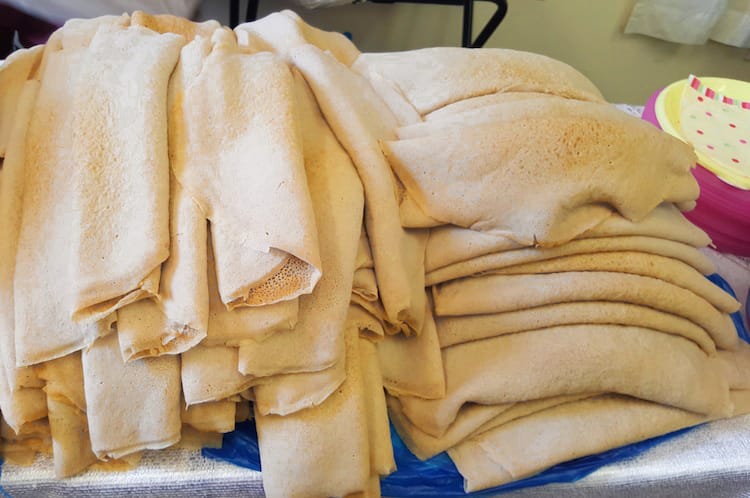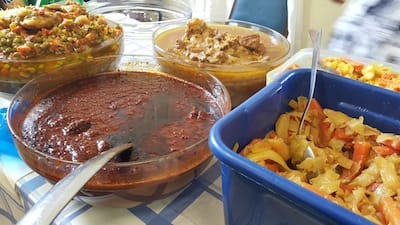What’s the best way to tell area residents about plans for a new asylum shelter nearby?
The government should tell communities directly about plans for new asylum shelters, some activists and politicians say.
You can get most foods in Dublin from the fermented tastes of Korea to the bean puddings of Nigeria. But there is a tragic gap in the city’s restaurant scene: there’s nowhere you can order a platter of fragrant Ethiopian stews. Why?

After the service on Sunday morning, members of the Ethiopian Orthodox Church head from the carpeted downstairs room where the service has been held, up a couple of flights of stairs and through a narrow corridor, to a hall on the top floor of the building.
Around the edge of the room are rows of chairs and several tables. There are about 100 people at the Lantern Centre on Synge Street for today’s service. Small and medium and big kids spring and jostle around the room, like wind-up toys set free.

At the tables at the front of the room, a few women are busy lining up some cans of Fanta and 7 Up, and shuffling a spread of dishes, the recognisable staples of the Ethiopian cuisine.
There are heaps of rolled-up spongy injera, tangy pancake-like bread. There are also big circular loaves that will shortly be cut into hunks of airy bread-like bread.
And there are bowls of rich stews. A thick red stew made with loads of onions and chunks of tender beef, called kay wot. A bowl of soft turmeric-tinged potatoes and carrots and cabbage, called ata-kilt. An enormous plate of yellow rice, and a chicken-and-pea-and-sweetcorn mix.
It looks eyes-bigger-than-belly delicious.
My search for Ethiopian food in Dublin started a while ago. I soon realised it would be difficult— although I didn’t realise it would end with me stalking members of the Ethiopian Orthodox Church, calling up, then dropping by, and wangling an invite to the next feast.
You can get most foods in the city – from the fermented tastes of Korea to the bean puddings of Nigeria. But there is a tragic gap in the city’s restaurant scene: there’s nowhere you can order a platter of fragrant Ethiopian stews.
Most people you ask, or whine at about it, have the same answer.
It’s probably because there aren’t many Ethiopians in Ireland, says Henok Abebe, a middle-aged guy sat next to me at the church meal, with a beanie and a self-deprecating sense of humour. “That’s my guess,” he says.
It is true that the number of Ethiopians in Ireland seems low.
Ethiopia has a large diaspora around the world, which grew from waves of emigration that began in the 1970s, with the overthrow of Emperor Haile Selassie and the start of the Marxist military regime, the Derg.
A second wave, in the 1980s, saw families migrate to join those who had made the journey first. The 1990s saw continued migration, as people fled political persecution and ethnic violence.
Most went to the United States and Canada. Those who came to Europe ended up mainly in Italy, Sweden, the United Kingdom, and the Netherlands.
As of 2011, there were still only 274 people listed in the census who had been born in Ethiopia and were usually resident and present in Ireland. Some argue that that figure is likely to be an underestimate.
Some Ethiopians might be registered as Eritreans, says Marta Abebe who lived and studied in Ireland for six years before recently moving to the United States.
But Ireland doesn’t come high on the list as a destination for many Ethiopians, she says. Some might be put off by how hard it is to get a visa, or for Ethiopian refugees to be recognised in Ireland. Others seem to fear racism.
“Whenever I returned home [to Ethiopia] for break, many people ask me how I survived the racism, while for me it was not a huge problem,” she said.
“Many Ethiopians do not understand that Ireland is economically developed and is part of the EU,” said Abebe. “Many friends unexpectedly asked me how poor Ireland is, just as many Irish ask me if there is any food in Ethiopia.”

At the church, I jump into the queue for the buffet, start with an injera bread to line my plate, and a woman ladles little piles of each of the stews on top. Okay, I just lied. They were big piles.
I squidge back into my seat, rip off some of the bread and scoop up the first of the stews. The kay wot is fragrant and spicy with a full, deep flavour that comes from hours and hours of simmering on the lowest heat.
The base is simple, with onions, ginger and garlic. The magic ingredients are time and berbere, a mix of spices that includes some old familiars such as basil and nigella seeds, and some that are less likely to be in your cupboard, such as korarima and ajwain. The ata-kilt is soft but not too mushy, delicate and almost sweet.
It is a sociable meal. I chat with Henok Abebe, who says he lives alone so he doesn’t like to cook that much, and a snappily dressed guy with a goatee on my right called Zelalem Dersehe, who says he’s quite the chef. “But whatever I cook, it tastes like Ethiopian food,” he says.
“I’ll show you something!” says Dersehe.
He tears off a strip of injera, scoops up some stew, and leans forward to feed a friend who is standing nearby. “Gorsha!” he shouts, as he shoves the rolled-up morsel into her mouth. She barely pauses in her conversation.
“It’s a sign of respect for someone, for someone you love, or a friend,” says Dersehe, leaning back again into his seat. “It has to be at least two times, not only once.”
“There’s a Simpsons episode about it,” he adds.
“Gorsha! Gorsha!” says Abebe, and cracks up.
After the meal is over, the priest stands for a prayer and the room follows, and a few boys draped with white gauze cloths recite in unison. They’re training to be deacons, says Abebe.
There’s no real mystery as to how cuisines spread around the world.
“People emigrate to a new country, and some of them open restaurants,” says Harry Kloman, a journalism professor at the University of Pittsburgh who has tracked the first Ethiopian restaurants to open in cities around the world. “The first Ethiopian restaurant in the US, in 1966, coincided with early immigration.”
“Sometimes people begin restaurants to serve their country-people and to be a gathering place, and then non-Ethiopians try the food,” he said. Other times, it’s just a lone ranger who has the means.
The first in Europe was in Rome in 1975. Now there are 50 European cities with firsts, from Karlsruhe in Germany, to Reading in England and Warsaw in Poland. But nowhere in Ireland.
There are a couple of places in the city that sell injera and will order in berbere spices. But they are not easy to find.
After following a few clues, I found myself on a rainy Monday morning in an African store with no visible bread on display, feeling like an idiot for asking if it might be sold there.
The guy disappeared into a back room, returned, and plopped a couple of bags of the good stuff in my arms.
Dublin’s injera makers operate in a grey area, cooking it in small batches in kitchens, and selling it for the most part to East Africans – Somali and Sudanese and Ethiopian and Eritrean injera-lovers – who have a taste for the stuff and search it out.
It’s hard to get the teff flour here to make it, so it tends to be made with the closest substitute from an Asian supermarket, mixed with self-raising flour. But when I crack open the packet at home, it has the familiar sour taste and pleasant squelch.
Abebe said he does recall one entrepreneurial sort who set up a shop on Moore Street that sold injera and spices a while ago, but that folded. “There’s a lot of people who do have a plan,” he says. “Including me.”
Perhaps he hears the desperation in my voice and is humouring me. Or perhaps, perhaps, perhaps, just maybe, it’s just a matter of time.